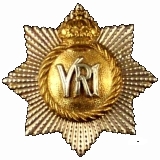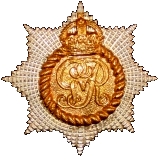
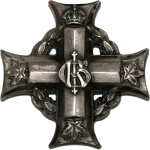
The First World War
Soldiers and Non-Commissioned Officers
of The Royal Canadian Regiment
477158 Private William Charles Carrothers
By: Captain Michael M. O'Leary, The RCR
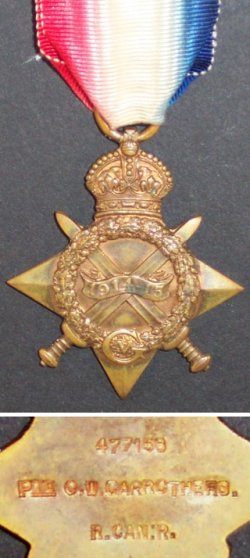
1914-15 Star awarded to 477158 Private William Charles Carrothers.
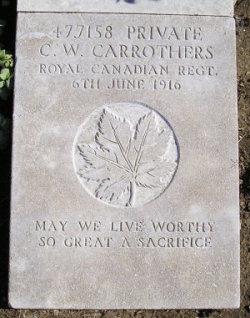
Private Carrulther's grave in the Boulogne Eastern Cemetery. Photo by Mick McCann, a member of British War Graves.
Charles William Carrothers (as named on his attestation form) was born 21 Nov 1891 at Westminster, Middlesex, a small community south of London, Ontario, Canada. The son of Ninian and Margaret Carrothers, of Wilton Grove, Ontario; the family is shown in the 1901 and 1911 censuses of Canada.
In 1901, Ninian Carrothers is shown living with his three sons (H. Roy, age 11; and W. Charles, age 9; and Gordon, age 2) and one daughter (G. Laura, age 12) along with a Servant Ellen Butcher. By the 1911 census the family includes all of the same members, except that Ellen was now recorded as Ninian's wife (and the children's step-mother). [Charles] Wilfred [sic] Carrothers was 19 at the time of the 1911 census.
Carrothers enlisted in The RCR on 31 August 1914 at London, Ontario. His original regimental number was 9871. He reattested for overseas service with the Royal Canadian Regiment at Halifax, Nova Scotia on 22 August 1915. His name does not appear in the November 1914 roll of the Regiment serving in Bermuda, but notes in his service record do show that he paraded there for an anti-typhoid inoculation during July 1915. Carrothers probably formed part of a 'topping up' draft to the Regiment while it was in Bermuda.
Carrothers, a farmer, reported on attestation for the CEF at 24 years of age. He was five foot, nine and three-quarters inches tall, with a fair complexion, blue eyes and brown hair.
On 1 Nov 1915, Carrothers crossed the Channel to France with The RCR as a soldier of "A" Company.
Carrothers story is supported by a surprisingly empty service record. The first entries after his disembarkation in France relate to his wounding on 4 June 1916. Carrothers was first treated at No. 3 Casualty Clearing Station on 4 June and then immediately transferred to No. 13 Stationary Hospital at Boulogne. Carrothers' wounds were described in his records as "shrapnel wounds, head, leg and wrist." He died of his wounds in hospital on 6 June 1916.
On the 3rd and 4th of June 1916, The Royal Canadian Regiment was in the front lines astride the Menin Road. The War Diary these days as follows:
3 June 1916
Weather fine. Wind W. At 9. a.m. the enemy drove the remainder of the P.P.C.L.I. from the APPENDIX this leaving our right flank in the air. Nothing of importance took place during the remainder of the day with the exception of the intermittent bombardments. Lieut. F.R.L. De SALIS was killed by H.E. Shrapnel. Lieut. E.E. McCALLUM was badly but not dangerously wounded while endeavouring to obtain information concerning the relative positions of the enemy's and our own line. He took two men with him, one of which was killed, the other badly wounded. The latter Lieut. McCALLUM bandaged as best he could and carried him back to R.H.Q. and then collapsed before his own wounds could be attended to Lieut. DAVIS was evacuated with shell shock. Great difficulty was experienced in evacuating the wounded even after dark but all were got safely out on this night.
4 June 1916
Lieut. MORRISON was wounded in the arm. Nothing of importance occurred with the exception of the usual Artillery activity which developed into intense bombardment at intervals.
The regimental history adds to the description of the 4th of June:
"For the next two days, the Regiment maintained its position in the line. On June 4, desultory shelling was endured, the casualties included Lieut. T.F. Morrison, who was wounded in the arm. At 10.30 a.m. on June 5, an intense bombardment badly damaged the right section of the Battalion's front line, but the Lahore guns in support retaliated and the German fire soon died down."
As a Private soldier of the Canadian Expeditionary force, William Carrothers was paid $1.00 per day with an additional 10 cents daily field allowance. Of this he assigned pay of $20 monthly back to his step-mother in Ontario. His records note that, at the time of his death, he had $3.16 cash found in his effects.
Private Charles William Carrothers is commemorated on page 64 of the First World War Book of Remembrance. He is buried at the Boulogne Eastern Cemetery, Pas de Calais, France (Grave Reference: 1914. VIII. B. 88).
Private Carrothers was entitled to the 1914-15 Star, the British War Medal and the Victory Medal. A scroll and Memorial Plaque were sent to his father in 1921. No Memorial Cross was issued.
(Carrothers' name is misspelled in the Library and Archives Canada database of Soldiers of the First World War as "Carruthers", and his given names are shown as "Charles Wilfred" in the Canadian Virtual War Memorial. (CVWM))
Two of William Carrothers' siblings also served in the Canadian Expeditionary Force; 823414 Gordon Carrothers and Nursing Sister Laura Georgena Carrothers
Pro Patria
- The O'Leary Collection; Medals of The Royal Canadian Regiment.
- Researching Canadian Soldiers of the First World War
- Researching The Royal Canadian Regiment
- The RCR in the First World War
- Badges of The RCR
- The Senior Subaltern
- The Minute Book (blog)
- Rogue Papers
- Tactical Primers
- The Regimental Library
- Battle Honours
- Perpetuation of the CEF
- A Miscellany
- Quotes
- The Frontenac Times
- Site Map

![]() The RCR in the Great War
The RCR in the Great War
![]() War Diary
War Diary
![]() Battle Honours
Battle Honours
![]() Battle Bars and The RCR
Battle Bars and The RCR
![]() The RCR Battle Bar Ledger (pdf)
The RCR Battle Bar Ledger (pdf)
![]() Honours and Awards
Honours and Awards
![]() Roll of Honour
Roll of Honour
![]() Prisoners of War
Prisoners of War
![]() Cemetery List
Cemetery List
![]() Cemetery Map
Cemetery Map
![]() Courts Martial
Courts Martial
![]() Officers
Officers
![]() RSMs of The RCR (1914-1919)
RSMs of The RCR (1914-1919)
![]() NCOs and Soldiers
NCOs and Soldiers
![]() An Officer's Diary (1914-1918)
An Officer's Diary (1914-1918)
![]() Recollections of a Nonagenerian (R. England) (1916-1919)
Recollections of a Nonagenerian (R. England) (1916-1919)
![]() On to Bermuda (1914-15)
On to Bermuda (1914-15)
![]() England and France 1915-1916 (Hayes; 1931)
England and France 1915-1916 (Hayes; 1931)
![]() Overseas with The Royals (1915)
Overseas with The Royals (1915)
![]() Regimental History Pamphlet (1917)
Regimental History Pamphlet (1917)
![]() Amiens (1918)
Amiens (1918)
![]() Cambrai (1918)
Cambrai (1918)
![]() Monchy-le-Preux (1918)
Monchy-le-Preux (1918)
![]() Under-aged Soldiers in The RCR
Under-aged Soldiers in The RCR
![]() Not All Were Volunteers; The RCR and the Military Service Act
Not All Were Volunteers; The RCR and the Military Service Act
![]() Sentenced to Death by Court Martial
Sentenced to Death by Court Martial
![]() The 7th Trench Mortar Battery
The 7th Trench Mortar Battery
![]() A Regimental Goat
A Regimental Goat
![]() Regiment and Family, Bermuda 1914-15
Regiment and Family, Bermuda 1914-15
![]() "March the Guilty Bastard In"
"March the Guilty Bastard In"
![]() Surrendered as Stowaway
Surrendered as Stowaway
![]() Re-Visiting the Great War Roll of Honour for The RCR
Re-Visiting the Great War Roll of Honour for The RCR
![]() Canadian Corps Trench Standing Orders (1916)
Canadian Corps Trench Standing Orders (1916)
